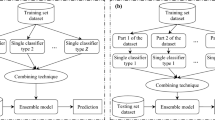Abstract
Early diagnosis and therapy are the most essential strategies to prevent deaths from diseases, such as cancer, brain tumors, and heart diseases. In this regard, information mining and artificial intelligence approaches have been valuable tools for providing useful data for early diagnosis. However, high-dimensional data can be challenging to examine, practically difficult to visualize, and costly to measure and store. Transferring a high-dimensional portrayal of the data to a lower-dimensional one without losing important information is the focal issue of dimensionality reduction. Therefore, in this study, dimensionality reduction-based medical data classification is presented. The proposed methodology consists of three modules: pre-processing, dimension reduction using an adaptive artificial flora (AAF) algorithm, and classification. The important features are selected using the AAF algorithm to reduce the dimension of the input data. From the results, a dimension-reduced dataset is obtained. The reduced data are then fed as input to the hybrid classifier. A hybrid support vector neural network is proposed for classification. Finally, the effectiveness of the proposed method is analyzed in terms of different metrics, namely accuracy, sensitivity, and specificity. The proposed method is implemented in MATLAB.




















Similar content being viewed by others
References
HemaShekar B, Dagnew G (2020) Deep learning approach for microarray cancer data classification. CAAI Trans Intell Technol 5(1):22–33
Shanthi S, Rajkumar N (2020) Lung cancer prediction using stochastic diffusion search (SDS) based feature selection and machine learning methods. Neural Process Lett 53:1–14
Salem H, Attiya G, El-Fishawy N (2017) Classification of human cancer diseases by gene expression profiles. Appl Soft Comput 50:124–134
Veer L, Da H, Bijver M et al (2002) Gene expression profiling predicts clinical outcome of breast cancer. Nature 415:530–536
Tarca AL, Romero R, Draghici S (2006) Analysis of microarray experiments of gene expression profiling. Am J Obstet Gynecol 195(2):373–388
Azar AT, Hassanien AE (2014) Dimensionality reduction of medical big data using neural-fuzzy classifier. Soft Comput 19(4):1115–1127
Liu Y, Liu Y, Chan KCC (2010) Tensor distance based multilinear locality-preserved maximum information embedding. IEEE Trans Neural Networks 21(11):1848–1854
Xu D, Yan S (2009) Semi-supervised bilinear subspace learning. IEEE Trans Image Process 18(7):1671–1676
Li X, Lin S, Yan S, Xu D (2008) “Discriminant locally linear embedding with high-order tensor data. IEEE Trans Man Cybernet Part B: Cybernet 38(2):342–352
Blue JL, Candela GT, Grother PJ, Chellappa R, Wilson CL (1994) Evaluation of pattern classifiers for fingerprint and OCR applications. Pattern Recog 27(4):485–501
Duda PO, Hart PE (1973) Pattern classification and scene analysis. Willey, New York
Coast DA, Stern RM, Cano GG, Briller SA (1990) An approach to cardiac arrhythmia analysis using hidden Markov models. IEEE Trans Biomed Eng 37(9):826–836
Tao D, Song M, Li X, Shen J, Sun J, Wu X, Faloutsos C, Maybank SJ (2008) “Bayesian tensor approach for 3-D face modeling. IEEE Trans Circuit Syst Video Technol 18(10):1397–1410
Aziz R, Verma CK, Srivastava N (2018) Artificial neural network classification of high dimensional data with novel optimization approach of dimension reduction. Annal Data Sci 5(4):615–635
Ma C, Guan J, Zhao W, Wang C 2018. An efficient diagnosis system for Thyroid disease based on enhanced Kernelized Extreme Learning Machine Approach. In: International Conference on Cognitive Computing. Springer, Cham, pp. 86-101
Shi J, Jiang Q, Zhang Q, Huang Q, Li X (2015) Sparse kernel entropy component analysis for dimensionality reduction of biomedical data. Neurocomputing 168:930–940
Lazcano R, Madroñal D, Salvador R, Desnos K, Pelcat M, Guerra R, Fabelo H, Ortega S, López S, Callicó GM, Juarez E (2017) Porting a PCA-based hyperspectral image dimensionality reduction algorithm for brain cancer detection on a manycore architecture. J Syst Architect 77:101–111
Tanaka T, Uehara T, Tanaka Y (2016). Dimensionality reduction of sample covariance matrices by graph fourier transform for motor imagery brain-machine interface. In: 2016 IEEE statistical signal processing workshop (SSP).
Singh DAAG, Leavline EJ, Priyanka R, Priya PP (2016) Dimensionality reduction using genetic algorithm for improving accuracy in medical diagnosis. Int J Intell Syst Appl 8(1):67
Adiwijaya WU, Lisnawati E, Aditsania A, Kusumo DS (2018) Dimensionality reduction using principal component analysis for cancer detection based on microarray data classification. J Comput Sci 14(11):1521–1530
Kandel BM, Wang DJ, Gee JC, Avants BB (2015) Eigenanatomy: Sparse dimensionality reduction for multi-modal medical image analysis. Methods 73:43–53
Author information
Authors and Affiliations
Corresponding author
Additional information
Publisher's Note
Springer Nature remains neutral with regard to jurisdictional claims in published maps and institutional affiliations.
Rights and permissions
About this article
Cite this article
Prakash, P.N.S., Rajkumar, N. HSVNN: an efficient medical data classification using dimensionality reduction combined with hybrid support vector neural network. J Supercomput 78, 15439–15462 (2022). https://doi.org/10.1007/s11227-022-04500-9
Accepted:
Published:
Issue Date:
DOI: https://doi.org/10.1007/s11227-022-04500-9




